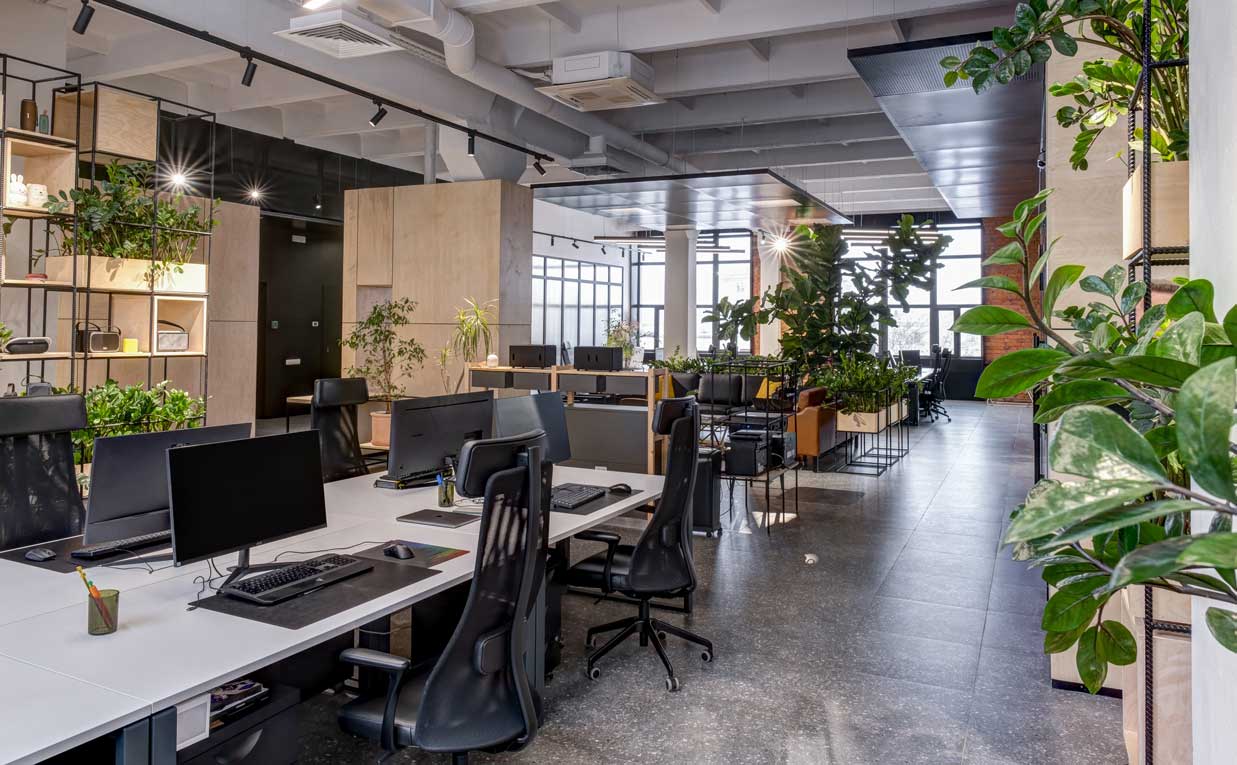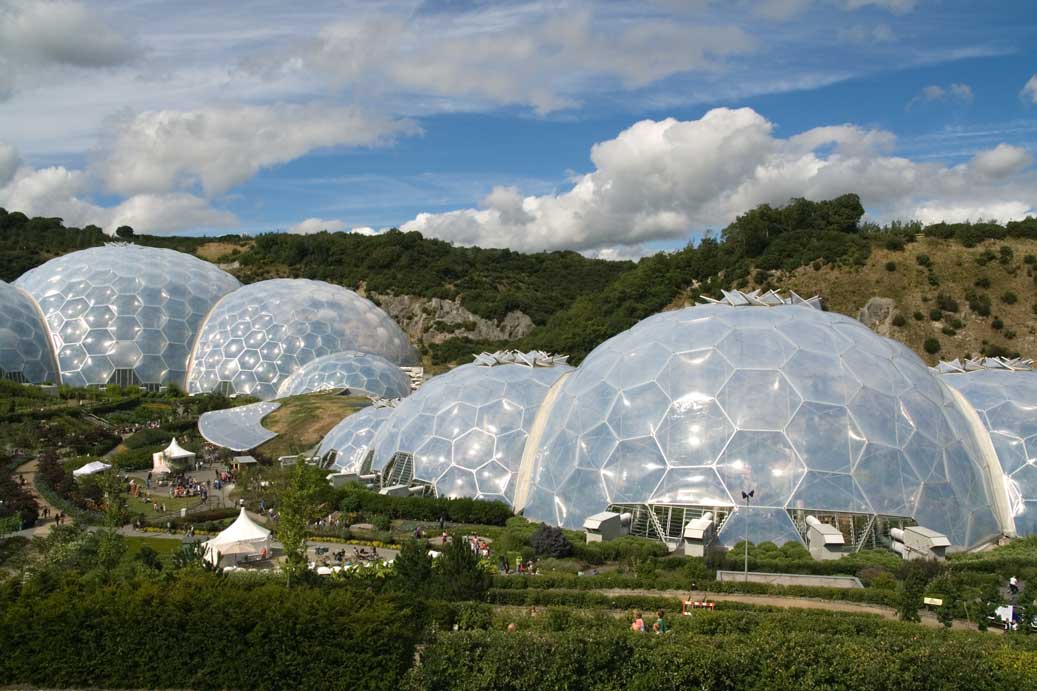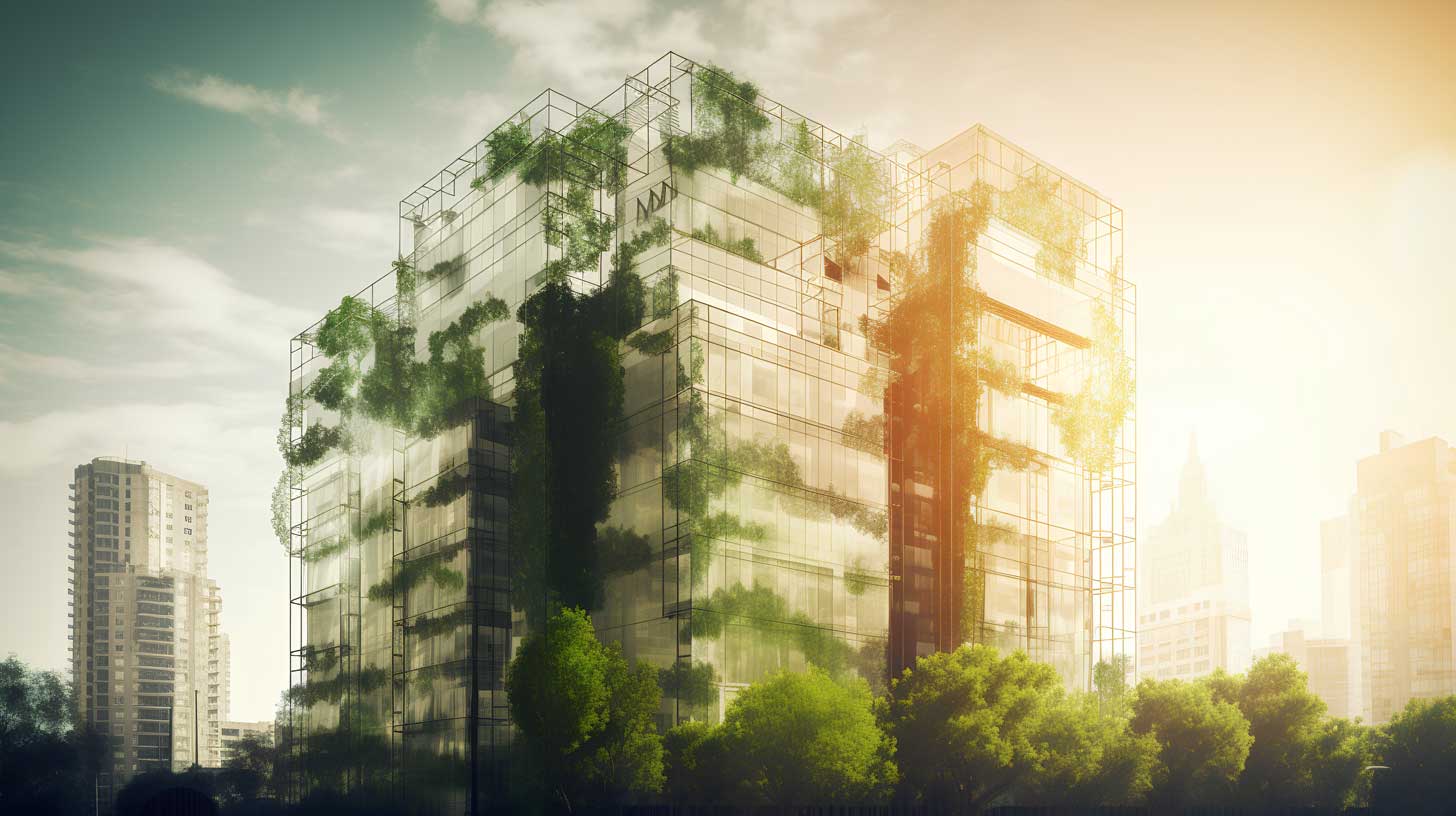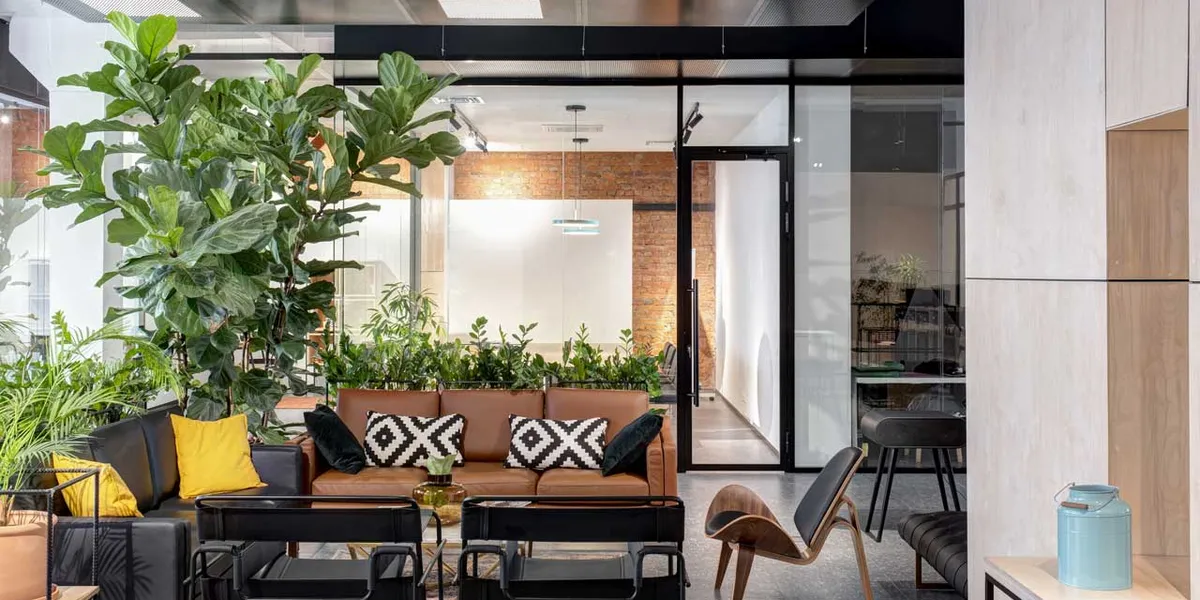In today’s rapidly urbanizing world, people are spending more time indoors and less time connected to nature. This disconnection has led to a growing recognition of the importance of integrating nature into our built environments (Browning, Ryan, & Clancy, 2014).
In architecture, this awareness has given rise to Biophilic Design, an approach that focuses on enhancing human-nature connections within our built spaces. By incorporating natural elements, Biophilic Design supports well-being, enhances productivity, and promotes sustainability (Kellert, Heerwagen, & Mador, 2008).
In this comprehensive guide, we’ll explore the core principles, benefits, and practical applications of Biophilic Design across various architectural projects, from residential homes to commercial spaces and beyond.
1. What is Biophilic Design?
Biophilic Design is an architectural design approach that seeks to connect people with nature within their built environments. The term “biophilia” was first popularized by biologist E.O. Wilson (1984), who argued that humans possess an innate affinity for nature.
Biophilic Design aims to harness this affinity by incorporating natural elements, patterns, and processes into architecture and interior design (Kellert, 2008). This approach not only enhances the aesthetic appeal of a space but also improves occupants’ physical and mental well-being (Browning et al., 2014).
Key principles of Biophilic Design include:
-
• Fostering a direct connection to nature through elements like natural light, water, and plants
-
• Encouraging indirect connections with nature through the use of organic shapes, natural materials, and biomimicry
-
• Creating spaces that facilitate human-nature interactions and stimulate the senses (Kellert et al., 2008)
2. Benefits of Biophilic Design
Incorporating Biophilic Design principles in architecture and interior design has been shown to yield numerous benefits for occupants, including the following:
Physical Health and Improved Well-being:
Exposure to natural elements can reduce stress, enhance cognitive function, promote overall mental health (Grahn & Stigsdotter, 2010), and contribute to improved cardiovascular health, reduced obesity, and enhanced immune system function (Maas et al., 2009).
Access to natural light has been linked to improved mood and reduced symptoms of depression (Beute & de Kort, 2018). Greenery and other natural elements can have a calming effect, reducing anxiety levels and promoting relaxation (Bratman, Hamilton, & Daily, 2012).
Furthermore, access to green spaces and natural light can encourage physical activity, contributing to overall health and well-being.
Increased Productivity and Psychological Well-being:
Studies have demonstrated that incorporating natural elements into workspaces can boost employee focus, creativity, and efficiency (Heerwagen, 2009).
Office workers with views of nature report higher job satisfaction, lower stress, and better cognitive function compared to those without such views (Kaplan, 1993). Workplaces with plants have been shown to increase employee productivity by up to 15% (Nieuwenhuis et al., 2014).
Biophilic Design creates spaces that promote relaxation, restoration, and mindfulness by incorporating elements like natural light, views of nature, and calming water features, contributing to a more balanced and fulfilling lifestyle.
Enhanced Sustainability and Social Cohesion
Biophilic Design often incorporates energy-efficient materials, natural ventilation, and other sustainable practices, contributing to reduced environmental impact (Browning et al., 2014).
Green roofs can help regulate building temperatures, reduce stormwater runoff, and promote biodiversity (Oberndorfer et al., 2007). Shared green spaces, such as parks, gardens, and courtyards, provide opportunities for social interaction and community engagement, contributing to overall social cohesion (Kuo et al., 1998).
Additionally, Biophilic Design elements can create a sense of place and identity, encouraging pride and attachment to one’s surroundings (Kellert, 2016).
By integrating nature into our built environments, Biophilic Design can promote stronger and more resilient communities.
3. Biophilic Design Elements and Strategies
Biophilic Design encompasses a wide range of strategies and elements to foster connections with nature. These can be grouped into three main categories: direct connections, indirect connections, and spatial configurations.
Direct Connections with Nature
-
• Natural light: Maximising daylight through windows, skylights, and light wells not only reduces reliance on artificial lighting but also has numerous health benefits, such as supporting circadian rhythms and improving mood (Figueiro & Rea, 2010; Boyce, 2014).
-
The use of daylighting strategies such as large windows, skylights, and light shelves should be prioritised to create spaces filled with natural light. Additionally, architects can consider the importance of sun orientation and shading devices to optimise light conditions throughout the day and the year.
-
• Water: Incorporating water features such as fountains, ponds, and rain gardens can provide both visual and auditory stimulation, creating a sense of tranquility and relaxation (Van Renterghem & Botteldooren, 2016).
-
The incorporation of water features such as ponds, fountains, and water walls, in designs can create soothing and restorative spaces that appeal to the senses.
-
• Plants: Integrating greenery through living walls, indoor gardens, and potted plants can improve air quality, reduce stress, and enhance cognitive function (Bringslimark, Hartig, & Patil, 2009; Nieuwenhuis et al., 2014).
-
By incorporating plants into designs in various ways, architects can aim to ensure that occupants are surrounded by nature, no matter where they are in the building.

Indirect Connections with Nature
-
• Biomimicry: Incorporating design features inspired by natural forms, patterns, and processes can evoke a sense of connection to nature (Benyus, 1997).
-
Examples include the self-cleaning properties of the lotus leaf, which has inspired the development of water-repellent materials, and the hexagonal structure of honeycombs, which can be used to create lightweight, durable building components.
-
Architects can draw inspiration from nature’s patterns and structures to inform our design choices, creating spaces that are not only visually appealing but also functional and sustainable.
-
• Organic shapes: Using non-linear, irregular shapes reminiscent of those found in nature can create a more visually interesting and engaging space (Hildebrand, 1999).
-
This might involve the use of curved walls, undulating ceilings, free-form furniture or patterns in textiles and other material finishes. By designing with this approach, architects can create spaces that are both aesthetically pleasing and in harmony with nature.
-
• Natural materials: Utilizing materials like wood, stone, and clay can provide a tactile connection to nature and contribute to a warmer, more inviting atmosphere (Dijkstra, Pieterse, & Pruyn, 2008). Architects often prioritise the use of materials such as wood, stone, and clay, selecting locally sourced and sustainably harvested options whenever possible.
Spatial Configurations
-
• Varied ceiling heights: Mimicking the varied canopy heights found in nature can create a more dynamic and engaging environment (Hildebrand, 1999). Use of this design approach can also create spaces that have a sense of depth and dimension.
-
• Transition spaces: Creating a gradual transition from indoors to outdoors through semi-enclosed spaces like courtyards, patios, and balconies can help blur the boundary between interior and exterior environments (Cooper Marcus & Sachs, 2014).
-
Designing spaces such as courtyards, terraces, and green roofs that serve as a bridge between the indoors and outdoors, offer opportunities for occupants to experience nature in a variety of settings.
-
• Prospect and refuge: Balancing open, expansive spaces with smaller, enclosed areas can offer a sense of security and exploration, satisfying our innate need for both observation and shelter (Appleton, 1975).
-
Architects strive to balance these elements, creating environments that provide a sense of security and comfort while also fostering a connection to the surrounding landscape.
4. Biophilic Design in Different Architectural Projects
Biophilic Design principles can be applied across a variety of architectural project types, enhancing both the aesthetic appeal and functional benefits of the built environment. Examples of these are as follows:
Residential
Incorporating Biophilic Design in residential architecture can create healthier, more comfortable living spaces that foster relaxation and rejuvenation (Kellert et al., 2008).
Elements such as natural light, greenery, and water features can contribute to a sense of well-being, while organic shapes and natural materials can enhance the overall visual appeal of the space.
Additionally, creating outdoor living areas, such as patios and gardens, can encourage interaction with nature and promote a greater sense of community among residents.
Commercial Office Spaces
Designing work environments that incorporate Biophilic Design principles can boost productivity, reduce stress, and increase employee satisfaction (Heerwagen, 2009).
Strategies such as providing access to natural light, incorporating greenery, and utilizing natural materials can create a more inviting and inspiring work environment.
Flexible workspaces that cater to different needs and preferences, such as quiet focus areas and collaborative spaces, can further enhance the employee experience by incorporating the principles of prospect and refuge.
The integration of biophilic design elements in flexible workspaces fosters a sense of comfort, security, and well-being, ultimately enhancing productivity and the overall employee experience.
Hospitality
Enhancing guest experiences in hotels, resorts, and restaurants through Biophilic Design can create restorative and memorable spaces that encourage relaxation and enjoyment (Browning et al., 2014).
This might involve integrating green walls, water features, or organic shapes to create a sense of connection to nature.
Designing spaces with a strong indoor-outdoor connection, such as outdoor dining areas and landscaped courtyards, can further enhance the guest experience by providing opportunities for immersion in nature.
Sporting Clubs
Integrating natural elements in recreational facilities can promote well-being, social interaction, and a sense of connection to the surrounding environment (Kellert et al., 2008). For example, incorporating natural light, greenery, and views of nature can create a more inviting and engaging space for both athletes and spectators alike.
Designing facilities that blend seamlessly with the surrounding landscape, such as incorporating native vegetation and natural materials, can further enhance the sense of connection to nature and promote a sense of place and identity.
Healthcare
Biophilic Design has been shown to have significant positive impacts on patient recovery, staff well-being, and overall healthcare experiences (Ulrich, 1999). Incorporating elements such as natural light, views of nature, and access to outdoor spaces can reduce stress, promote healing, and improve patient outcomes.
Designing therapeutic gardens and healing landscapes can provide additional opportunities for patients, staff, and visitors to connect with nature and find respite during their time at the facility.
Educational facilities
The implementation of Biophilic Design principles in schools and other educational settings can create more stimulating and nurturing learning environments that support cognitive development and well-being (Kellert, 2005).
Strategies may include providing access to natural light, incorporating greenery, and designing spaces that foster a sense of connection to the surrounding environment.
Additionally, creating outdoor learning spaces, such as gardens and nature trails, can offer students opportunities for hands-on learning and exploration in a natural setting.
Retail spaces
Incorporating Biophilic Design in retail environments can enhance the shopping experience and create a more inviting and engaging atmosphere for customers (Joye, 2007).
Integrating elements like natural light, greenery, and organic shapes can evoke a sense of connection to nature and contribute to a more pleasant and memorable shopping experience.
Additionally, creating outdoor shopping areas and incorporating landscape features, such as courtyards and water features, can further enhance the retail environment and encourage customers to linger and explore.
5. Biophilic Design Examples
The following are some notable examples of Biophilic Design in various architectural contexts, showcasing the breadth and impact of this design approach:
-
• The Eden Project, Cornwall, UK: This environmental education center features the world’s largest indoor rainforest housed within a series of geodesic domes. The space invites visitors to connect with nature and learn about the importance of biodiversity and conservation.
-
• The Bullitt Center, Seattle, USA: Dubbed the “greenest commercial building in the world,” the Bullitt Center incorporates elements such as a green roof, rainwater harvesting system, and smart technology to create a healthy and sustainable work environment.
-
• Bosco Verticale, Milan, Italy: These residential towers feature lush vertical gardens on their façades, offering residents a direct connection to nature in an urban setting.
-
• 1 Hotel Brooklyn Bridge, New York, USA: This eco-conscious hotel combines natural materials, abundant greenery, and expansive views of the East River and Manhattan skyline to create a serene, nature-inspired guest experience.

6. Best Practices for Implementing Biophilic Design
Implementing Biophilic Design can be both an art and a science. Architects, incorporate the following best practices into a Biophilic Design approach:
-
• Starting with the basics: A focus on fundamental elements like natural light, greenery, and water to establish a strong connection to nature.
-
• Engaging Stakeholders: Active engagement with clients, end-users, and other stakeholders to better understand their needs, preferences, and connections to the natural world. By involving stakeholders in the design process, we can create spaces that not only embody Biophilic Design principles but also resonate with the people who will use and inhabit them.
-
• Site analysis and context: Architects carefully assess the unique characteristics of each project site, including its ecological, cultural, and historical context, to inform our design decisions. This analysis allows us to create spaces that are sensitive to the local environment and contribute to the broader goals of sustainability and resilience.
-
• Consideration of the local context: The selection of materials and design features are generally those that reflect the local natural environment and cultural heritage.
-
• Collaboration with experts: A truly integrated design can be created by working closely with horticulturists, ecologists, and other specialists. By employing an integrative design process that encourages collaboration among architects, engineers, landscape architects, and other specialists we can develop holistic solutions that address multiple aspects of Biophilic Design.
-
This interdisciplinary approach ensures that buildings are not only aesthetically pleasing but also functional, sustainable, and supportive of human well-being.
-
• Being mindful of scale: It is important to remember that Biophilic Design can be effective on both small and large scales, from a single room to an entire building complex.
-
• Thinking holistically: Biophilic Design principles should be incorporated throughout the entire design process, from site selection to the choice of interior finishes.
-
• Monitoring and Evaluation: Designs should be subject to ongoing monitoring and evaluation to ensure that they are achieving their intended goals and delivering the desired benefits of Biophilic Design.
-
By tracking performance metrics related to occupant satisfaction, health, and environmental impact, design strategies can be refined and improved our over time.
7. Overcoming Challenges in Incorporating Biophilic Design
Despite its many benefits, architects and other design professionals may face some challenges when integrating Biophilic Design, including the following:
Limited space
In densely populated urban areas, finding space for greenery and other natural elements can be challenging. Solutions include vertical gardens, rooftop gardens, green balconies, and incorporating greenery into building facades.
Additionally, nature-inspired artwork, materials, and patterns can be included to evoke a sense of connection to nature in space-constrained environments.
Maintenance
Natural elements like plants and water features require ongoing care. Consideration can be given to low-maintenance plant species and drought-resistant plants. In some cases it may be necessary to enlist professional maintenance services to ensure the long-term success.
By utilising automated irrigation systems and selecting plants suitable for the specific microclimate and light conditions, it is also possible to reduce maintenance efforts.
Budget Constraints
Some Biophilic Design features can be costly. It is therefore important to look for cost-effective alternatives, such as using locally sourced materials and prioritising high-impact elements like natural light and greenery.
Implementing energy-efficient design features, such as passive solar design and natural ventilation, can also help to offset initial costs by reducing long-term energy consumption.
Regulatory Barriers
Local building codes and regulations can sometimes pose challenges to the implementation of Biophilic Design elements.
To overcome this, it is necessary to collaborate closely with local authorities, planners, and stakeholders to develop a shared vision and ensure compliance with applicable regulations. By educating decision-makers on the benefits of Biophilic Design, we can help to create a more supportive regulatory environment.
Balancing Aesthetics and Function
Integrating natural elements into a design can sometimes be challenging from an aesthetic standpoint.
By collaborating with landscape architects, horticulturists, and other specialists we can create harmonious, visually appealing spaces that effectively blend form and function.
Consideration should also be given to a variety of plant species, textures, and colors to create dynamic, engaging spaces that evoke the complexity and richness of nature.
By addressing these challenges, architects and designers can successfully incorporate Biophilic Design principles into their projects, creating spaces that promote well-being, sustainability, and a strong connection to the natural world.

8. The Future of Biophilic Design
As awareness of the importance of nature in our built environment continues to grow, so too will the role of Biophilic Design in shaping the future of architecture. Emerging trends and innovations include:
Biophilic Urban Planning
Biophilic design principles can be extended to encompass entire cities and communities, promoting green infrastructure, walkability, and ensuring access to natural spaces for all residents, thus enhancing the overall urban living experience (Beatley, 2010).
Cities such as Singapore and Melbourne have embraced Biophilic Design principles in their urban planning efforts, creating green corridors, revitalizing waterfront areas, and integrating nature into their public spaces.
These examples demonstrate the potential of Biophilic Design to enhance the liveability and sustainability of entire cities and communities.
Net-positive Buildings
The concept of net-positive buildings, which produce more energy than they consume and actively contribute to environmental and social well-being, is gaining traction in the architectural and design community.
Biophilic Design can play a critical role in creating net-positive buildings by incorporating natural systems and processes that support energy efficiency, water management, and occupant health.
Regenerative Design
Going beyond sustainability to create built environments that actively contribute to the health and resilience of ecosystems, integrating Biophilic Design principles with closed-loop systems, renewable energy, and habitat restoration (Mang & Reed, 2012).
Examples of regenerative design projects include the Ecolife Capitol building in Hanoi, Vietnam, which features a facade covered in greenery and a rooftop garden, contributing to improved air quality and reduced urban heat island effect.
Biophilic Cities
The Biophilic Cities Network, founded by Dr. Timothy Beatley, promotes the integration of nature into urban environments at a city-wide scale. Cities in the network, such as Singapore, Portland, and San Francisco, are actively implementing Biophilic Design strategies to improve urban biodiversity, air quality, and overall quality of life for their residents.
The Final Word…
Biophilic Design is an essential approach for creating healthier, more sustainable, and engaging built environments. By understanding and applying its core principles, architects and designers can enhance human-nature connections and promote well-being across a wide range of architectural projects.
As the importance of nature in our lives continues to be recognized, Biophilic Design will play an increasingly vital role in shaping the future of architecture.
Are you inspired by the transformative power of Biophilic Design? Don’t miss the opportunity to create a healthier, more sustainable, and connected environment for your next architectural project.
Contact us to discuss how we can help bring your vision to life through the power of Biophilic Design.
References:
References: Appleton, J. (1975). The Experience of Landscape. John Wiley & Sons. Barbosa, O., & Gifford, R. (2019). The Future of Biophilic Cities: The Psychological and Environmental Benefits of Nature in Urban Spaces. In H. Nagendra & H. Bai (Eds.), Cities and Canopies: Trees in the Urban Landscape. Cambridge University Press. Beatley, T. (2010). Biophilic Cities: Integrating Nature into Urban Design and Planning. Island Press. Benyus, J. M. (1997). Biomimicry: Innovation Inspired by Nature. HarperCollins. Boyce, P. R. (2014). Human Factors in Lighting. CRC Press. Bratman, G. N., Hamilton, J. P., & Daily, G. C. (2012). The impacts of nature experience on human cognitive function and mental health. Annals of the New York Academy of Sciences, 1249(1), 118–136. Bringslimark, T., Hartig, T., & Patil, G. G. (2009). The psychological benefits of indoor plants: A critical review of the experimental literature. Journal of Environmental Psychology, 29(4), 422–433. Browning, W. D., Ryan, C. O., & Clancy, J. O. (2014). 14 Patterns of Biophilic Design. Terrapin Bright Green, LLC. Cooper Marcus, C., & Sachs, N. A. (2014). Therapeutic Landscapes: An Evidence-Based Approach to Designing Healing Gardens and Restorative Outdoor Spaces. John Wiley & Sons. Dijkstra, K., Pieterse, M. E., & Pruyn, A. (2008). Stress-reducing effects of indoor plants in the built healthcare environment: The mediating role of perceived attractiveness. Preventive Medicine, 47(3), 279–283. Figueiro, M. G., & Rea, M. S. (2010). The effects of red and blue lights on circadian variations in cortisol, alpha amylase, and melatonin. International Journal of Endocrinology, 2010. Grahn, P., & Stigsdotter, U. K. (2010). The relation between perceived sensory dimensions of urban green space and stress restoration. Landscape and Urban Planning, 94(3-4), 264–275. Heerwagen, J. (2009). Biophilia, health, and well-being. In Biophilic Design: The Theory, Science, and Practice of Bringing Buildings to Life (pp. 271-287). John Wiley & Sons. Hildebrand, G. (1999). Origins of Architectural Pleasure. University of California Press. Kaplan, R. (1993). The role of nature in the context of the workplace. Landscape and Urban Planning, 26(1-4), 193-201. Kellert, S. R. (2005). Building for Life: Designing and Understanding the Human-Nature Connection. Island Press. Kellert, S. R., Heerwagen, J., & Mador, M. (2008). Biophilic Design: The Theory, Science, and Practice of Bringing Buildings to Life. John Wiley & Sons. Miller Hull Partnership. (2013). The Bullitt Center. Retrieved from https://millerhull.com/portfolio/the-bullitt-center/ Nieuwenhuis, M., Knight, C., Postmes, T., & Haslam, S. A. (2014). The relative benefits of green versus lean office space: Three field experiments. Journal of Experimental Psychology: Applied, 20(3), 199-214. Oberndorfer, E., Lundholm, J., Bass, B., Coffman, R. R., Doshi, H., Dunnett, N., Gaffin, S., Köhler, M., Liu, K. K. Y., & Rowe, B. (2007). Green roofs as urban ecosystems: Ecological structures, functions, and services. BioScience, 57(10), 823-833. Ulrich, R. S. (1999). Effects of gardens on health outcomes: Theory and research. In C. Cooper Marcus & M. Barnes (Eds.), Healing Gardens: Therapeutic Benefits and Design Recommendations (pp. 27-86). John Wiley & Sons. Van Renterghem, T., & Botteldooren, D. (2016). View on outdoor vegetation reduces noise annoyance for dwellers near busy roads. Landscape and Urban Planning, 148, 203-215. Wilson, E. O. (1984). Biophilia. Harvard University Press.

